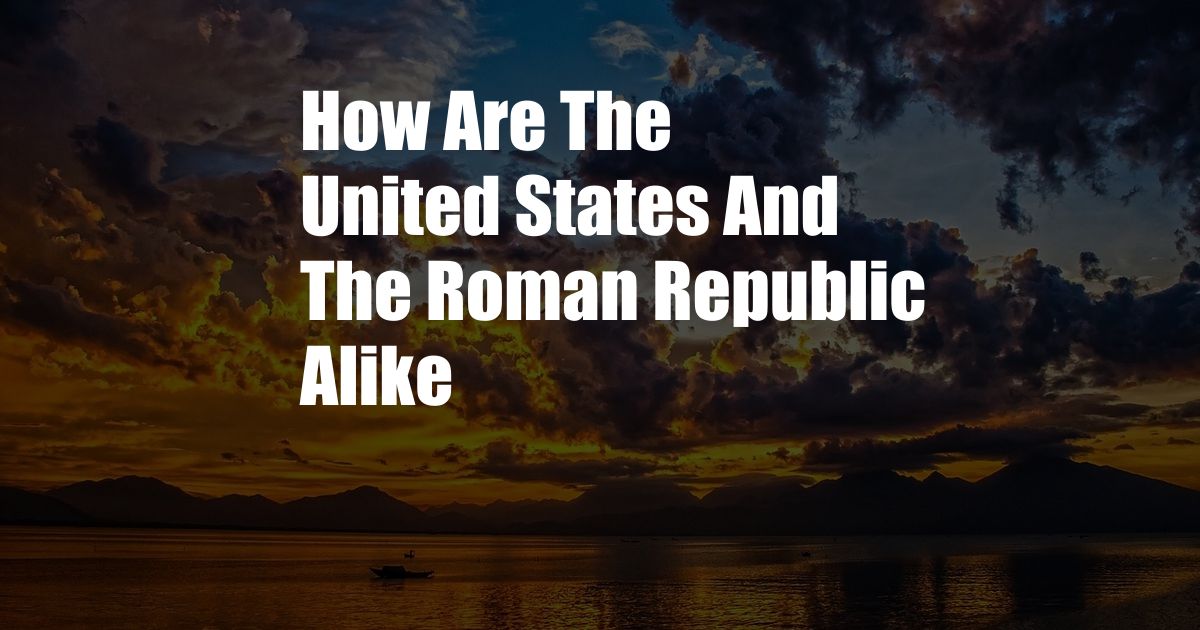
The United States and the Roman Republic: Parallels and Contrasts
The Seeds of Democracy
In the bustling streets of ancient Rome, where chariots rumbled and senators debated, a remarkable civilization flourished. Across the vast expanse of time and oceans, a young nation emerged on the shores of North America, inspired by the ideals that had shaped Rome centuries before. This nation, the United States, would become a beacon of democracy and a testament to the enduring power of the principles that had guided its ancient predecessor.
The Pillars of Government
At the heart of both the United States and the Roman Republic lay a shared commitment to representative government. The Roman Senate, comprising elected officials representing the interests of diverse constituencies, served as the legislative body. Similarly, the United States Congress, composed of the Senate and the House of Representatives, embodies the principles of representative democracy. Both systems recognized the importance of balancing power among different branches of government, ensuring checks and balances to prevent the concentration of authority.
The Role of the People
Popular sovereignty, the idea that ultimate political power resides with the people, was a cornerstone of both societies. In the Roman Republic, citizens participated in public assemblies to elect officials and make laws. The United States, too, embraces this fundamental principle through its democratic elections and the right to participate in political discourse. In both civilizations, the active engagement of citizens in the governance of their societies fostered a sense of ownership and responsibility.
The Challenges of Expansion
The United States and the Roman Republic both experienced periods of rapid expansion, leading to significant challenges. As the Roman Empire grew to encompass vast territories, it faced the complexities of managing diverse populations and maintaining stability on its frontiers. The United States, too, encountered similar challenges as it expanded westward. The westward expansion brought new territories under its control, but also raised questions about the rights of Native American tribes and the proper balance between central and local authority.
The Shadows of Empire
Despite their democratic origins, both the Roman Republic and the United States have faced periods of imperial ambition. The Roman Empire expanded through military conquest, seeking to dominate vast tracts of land and control distant provinces. Similarly, the United States has engaged in various military interventions and international conflicts, sometimes raising concerns about the potential for overreach and the erosion of democratic principles.
Lessons from History
The parallels between the United States and the Roman Republic offer valuable lessons for modern society. Just as the Roman Republic eventually succumbed to autocracy, the United States must remain vigilant in safeguarding its democratic institutions and ensuring that power remains accountable to the people. The principles of popular sovereignty, representative government, and checks and balances are essential for maintaining a just and equitable society.
Tips and Expert Advice
To strengthen democratic principles and foster a thriving society, consider the following tips and expert advice:
- Engage in civic participation: Take an active role in your community and participate in political processes.
- Promote political discourse: Engage in respectful and informed conversations about public affairs, even with those you disagree with.
- Support independent media: Provide support for independent journalism, which plays a vital role in holding those in power accountable.
- Educate future generations: Instill in young people the importance of civic literacy and democratic values.
Frequently Asked Questions
Q: What are the key similarities between the United States and the Roman Republic?
A: Both societies were founded on principles of representative government, popular sovereignty, and checks and balances.
Q: How did the Roman Empire’s expansion differ from that of the United States?
A: The Roman Empire expanded through military conquest, while the United States expanded primarily through westward settlement and territorial acquisition.
Q: What lessons can we learn from the history of the Roman Republic and the United States?
A: We can learn the importance of safeguarding democratic institutions, promoting civic participation, and valuing the rule of law.
Conclusion
The United States and the Roman Republic, separated by centuries and oceans, share a remarkable legacy of democratic ideals. By understanding the parallels and contrasts between these two societies, we can gain insights into the strengths and challenges of representative government. As we navigate the complexities of modern society, we must remain committed to the principles that have shaped our nations and ensure that our democracies continue to thrive for generations to come.
Do you find the topic of comparisons between historical societies fascinating? Share your thoughts in the comments below.